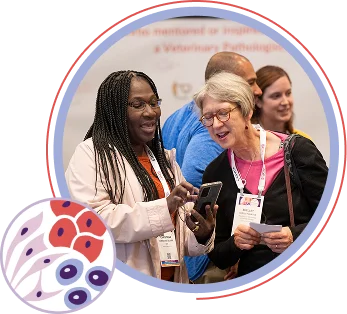Networking 101, Networking for All
Take full advantage of networking opportunities with these helpful tips designed to strengthen collaboration, identify mentors, and expand perspectives within our diverse field.

We are excited to see everyone at the ACVP Annual Meeting, share key updates, and reconnect with colleagues. The annual meeting is not only an opportunity to learn about the latest Research, but also a space to build connections that can shape your career. For ACVP members, networking can be especially valuable in strengthening collaborations, identifying mentors, and expanding perspectives within our diverse field.
While many of us may be excited to speak with new faces and get to know each other, making those initial connections can often feel like a daunting task, and can even be anxiety inducing. For those looking to establish genuine connections, here are some helpful tips:
Start Simple
A simple and genuine opener, such as asking what sessions someone is most excited about, often works best. Active listening is key in any conversation, leaving space for the other person to share their story. Make the exchange more engaging by asking open-ended questions about their career path or current projects. Asking about training, research interests, or what someone enjoys about their role is usually well received. As an example, rather than simply asking “What do you do?” and moving on, perhaps a more efficient means of establishing a connection may be to follow up with “What do you enjoy about what you do?” or “What do you think is the most valuable part of your work?”
Be Inclusive
While networking, there are certain spoken and unspoken cues that can be utilized to ensure you are leaving the conversation open for others to join. If you are with a group, try to keep an open space in the group, rather than a closed off circle. If you notice someone who seems interested in connecting, make eye contact and invite them to join, or if you know them by name, try calling them over. Remember that networking can often be about helping others, especially those just starting out their careers.
Share Freely, Respect Boundaries
Sharing more detailed parts of your life can be an easy way to establish connections when networking. This process, known as self-disclosure, has been shown to build and deepen connections with others, and often leads to reciprocal sharing from others in the conversation. However, it is important to note that all individuals differ in their comfort level, and you may not want to pry or ask others to share anything they do not want to. Certain topics, such as politics, religion, and a person’s physical appearance, are best avoided when meeting someone new in a networking situation.
Be Aware of Others’ Needs
For many, networking and meeting new people can be an overwhelming experience. Traditional networking often relies on fast-paced small talk, unspoken social cues, and crowded environments that can unintentionally exclude neurodivergent professionals. For those who process information differently, these settings can be overwhelming and may limit opportunities to form meaningful professional connections.
To make networking more neuroinclusive, neurodiversity expert Ludmila Praslova emphasizes rethinking how we design these interactions. Providing structure and advance notice, such as sharing agendas, discussion topics, or participant lists ahead of time, gives attendees the chance to prepare and feel more confident. Offering multiple ways to participate, including virtual platforms or written exchanges, ensures that those who find spontaneous verbal communication challenging can still engage fully. Adjusting the environment is also important: smaller groups, quieter spaces, or clearly structured introductions can reduce sensory overload and ease the pressure of unstructured mingling. Organizers can enhance inclusion by offering opt-out spacesfor those who need breaks and by educating participants about neurodiversityso that different communication and social styles are respected. These changes are more than simple accommodations–they create equitable access to opportunities.
Ultimately, networking does not need to be overwhelming or inauthentic. At its heart, it is about curiosity, respect, and shared enthusiasm for veterinary pathology. Each conversation, no matter how brief, is an opportunity to learn, contribute, and strengthen our community.
Brought to you by the ACVP DEI Committee.